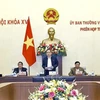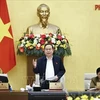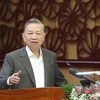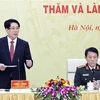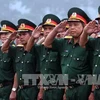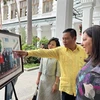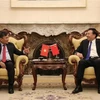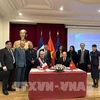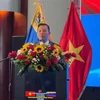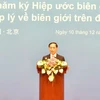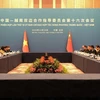HCM City (VNA) – Ho Chi Minh City has made great contributions to the nation’s development through a series of renewal policies, especially promoting market-oriented economic development and international integration.
Since 1975, after the country was reunited, the municipal authorities introduced unprecedented steps in the spirit of dynamism and creativity, paving the way for the nation’s Doi Moi (Renewal) process.
Looking back at the city’s development process, Pham Chanh Truc, former Vice Standing Secretary of the Municipal Party’s Committee and former deputy head of the Party Central Committee's Economic Commission highlighted the efforts made by municipal authorities to raise economic development and improve local incomes.
According to Phan Xuan Bien, former head of the Municipal Party Committee ’s Commission for Information and Education , many breakthrough measures were rolled out to boost economic development, focusing on removing subsidisation, promoting industry and trade, ventures, and material imports, and vitalising the craft industry.
Tran Du Lich, deputy head of the city’s National Assembly (NA) Deputy Delegation, said that since the 1980s, HCM City has piloted a three-part plan under resolutions approved by the Council of Ministers, which aimed to expand direct exports, imports and local production, while supporting State enterprises in the city.
The city has worked with other localities specialising in agricultural production to spur industry-agriculture-trade relations to create farm produce for export.
To ensure food supplies and other commodities, groups to purchase food in Mekong Delta provinces were set up. Municipal authorities also asked the Government to establish the first food trade company in a bid to stop food subsidy.
The “Da Lat Conference” in July 1983 marked a milestone and outlined HCM City’s development policy, serving as a premise for the country’s reform process.
Directors of the city’s enterprises that had new ideas were invited to meet State and Government leaders at the conference to report their firms’ development.
At the start of the renewal process, HCM City defined an export-targeted economic strategy. By learning from other countries, municipal authorities proposed the construction of concentrated export processing and industrial zones in the city.
HCM City is home to 16 export processing and industrial zones. Established in 1991, the Tan Thuan export processing - the first in the country - is a typical success story.
Vo Chon Trung, former head of the HCM City Export Processing and Industrial Zones Authority (Hepza) in the city, said the parks have contributed to training and attracting high-quality human resourses and developing modern management methods over the last 24 years, thus promoting the industrialisation and modernisation process.
Additionally, the city also contributed to development of types of enterprises. In 1989, the municipal People’s Committee issued a decision on the types of enterprises, such as private businesses, limited liability companies and joint stock companies in order to facilitate the private sector’s development. This was practical basis for the approval of the Law on Private Enterprises and the Law on Enterprises at the 8th National Assembly.
Along with encouraging the development of the private sector, municipal authorities proposed the Government to pilot the equitisation of State-owned enterprises in 1992. This became a general policy in 1996.
During 1986-1990, a wide range of collective credit institutions were established under the form of credit funds and credit cooperatives, and credit and investment centres. Sai Gon Industry and Trade Bank - the first joint stock bank in Vietnam - was formed in Ho Chi Minh City in October 1987.
The National Assembly promulgated the Ordinance on State Bank on May 23, 1990, facilitating the development of commercial joint stock banks.
Amid the increasing integration, HCM City, as a leading force in various fields, has been making stronger efforts to foster sustainable development and international integration.
The city’s contribution to the State budget accounted for 27.7 percent of the total in 2011. The figure rose to 30 percent in 2014. The city’s proportion economic in the country’s economy increased to 21.5 percent in 2014 from 18.3 percent in 2011. Up to 5,765 foreign-invested projects worth over 40.5 billion USD have operated in the city as of the end of 2015.
The 10 th Congress of the city’s Party Organisation in 2015 defined that HCM City will pursue fast and sustainable economic development, while shifting to economic-oriented and green growth models and improving growth quality and competitiveness.
The city has also targeted the expansion of advanced science and technology application and training high-quality human resources, aiming to create added value to goods and services.
It will focus on developing nine key service sectors and four industrial sectors with high added value, determining the main products to join global value chain, promoting exports and developing industries serving agriculture.
The city will also develop and effectively manage goods, finance, science-technology, real estate and labour markets.
Vice Standing Secretary of the Municipal Party’s Committee Vo Van Thuong said the city’s Party Committee and authorities are determined to fully tap the city’s combined strengths and intensify renovation and creativity to bring greater development to the city.-VNA





